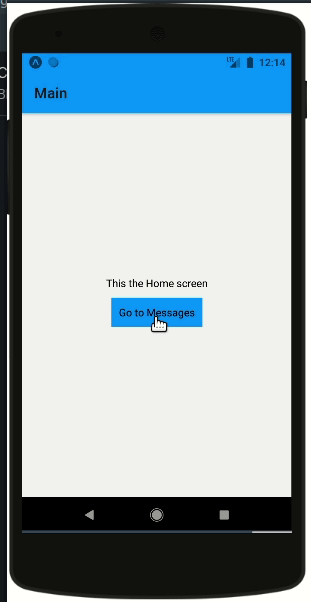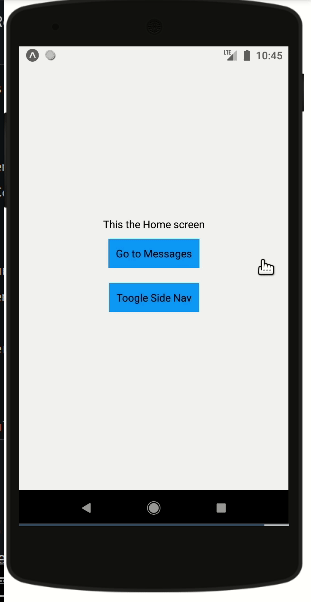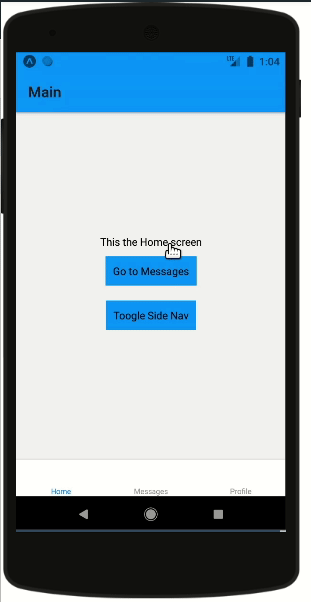What is React Navigation?
React Navigation is a react native library for routing and navigation. It is the popular choice for most react native developers because of how easy it is to integrate into react native applications. The current version React Navigation v5 saw a complete rewrite of v4 and came with some highlights such as;
- Hooks: Hooks introduced in React v16.8 allows you to use state and other React features in functional components. It also allows you to create other custom hooks which abstract component logic into reusable functions. React navigation v5 saw the introduction of custom hooks for common use cases.
- New Theming API: The theming API of React Navigation was a complete revamp of the previous version and saw the introduction of features such as dark mode, and also customization of other built-in components.
- Component-Based Configuration: before React Navigation v5 you would have to statically configure the navigator using functions like createXNavigator, now you can make all those configurations inside the built-in components and they are also dynamic.
- Redux DevTools Integration: v5 saw react native navigation integrated into Redux dev-tool extension which allows you to be able to view and debug navigation actions from a browser console.
Prerequisites
To follow along with this tutorial you should have:
- Knowledge of JavaScript and React
- Knowledge of React native
- Node v12 or greater
- npm and/or yarn
- An emulator to test the application
Setting up a React Native project
Before we install react-navigation we will need an existing react native project so let’s get started by creating a react native project with Expo. Expo is a framework for building and testing React native applications quickly.
Open a terminal and run the code below:
The code above installs the expo-cli which is a set of command tools that helps in creating, developing, building, and publishing react native applications. After installing Expo the next line initializes a new Expo project.
We now have a react native project to run it, on your terminal run expo start and choose your emulator of choice. Alternatively, you can write and run your code with Snack which is an expo online editor.
Creating Screens
After initializing a react native application. The next step is creating the screens required for the application. To effectively show how the different navigators can be combined in an application we will be creating four screens: Home.js, Messages.js, Profile.js, and Cart.js.
Navigate to the root directory of the project and create a directory called screens. Create the following files as itemized below in the screens directory and paste their respective code into them:
- Home.js
- `Messages.js`
- Profile.js
- Cart.js
We now have the necessary screens we will need for building a navigation structure. Let us move forward.
Installing React Navigation
Now that we have a react native application we can go ahead to install the react-navigation.
Navigate to the project directory,
and run the code below to install the react navigation library.
React navigation has some dependencies which are core utilities used by navigators when creating the navigation structure of your application. Run the code below to install those dependencies
The code above will install the recommended versions of the dependencies for expo-managed projects. To install in a react native project not managed by expo run the code below
Types of Navigators
Navigators help in defining the structure of the navigation of an app. Before we combine navigators, lets walk-through the various navigators react-navigation offers.
Stack Navigator
The stack navigator is a navigator that has a behavior similar to that of a web browser history stack. When a user moves forward to another screen, the screen is added to a stack, and when they go backward the current screen is popped off from the stack. The major difference between a web browser history stack and the Stack Navigator of React Navigation is the added gestures and animations which give a more native-like experience to the users.
To get started with the React Navigation stack navigator, navigate to the project root and run the code below to install the stack navigator:
This installs the react-navigation stack navigator library. Each react-navigation navigator comes with its library which is dependent on the set of libraries we installed earlier.
Create a folder called navigation in the root directory this is where our navigators will live. Navigate to the navigation directory and create a file called StackNavigator.js. Open the file and paste the code below
The createStackNavigator is a function that returns a Navigator and Screen component used in configuring a stack navigator. The Navigator is a container component that takes the Screen components as children and shouldn’t be embedded in a Screen component.
The name props passed to Stack.Screen is the route of the component to be rendered, so when a user navigates to “Messages” the Messages component is rendered.
Open the App.js file and replace the boilerplate code with the code below:
The first change here is the NavigationContainer which has been imported from the React Navigation library. The NavigationContainer is a component that is responsible for managing the navigation state and navigation tree. It is a top-level component responsible for wrapping the navigators so it is advised to render the NavigationContainer at the root of the application.
At this point, you can save and view the application in your emulator. It initially renders the Home component of our Navigator. We can override this behavior by passing an initialRouteName as props to the Navigator component in the StackNavigator.jsfile.

Additionally, we can modify and style the header of a screen by passing an options prop to the Screen component in the StackNavigator.js file. Open the file and refactor the Home screen:
We’ve renamed the title of the Home component to Main and changed the background color of the header.

To navigate between screens we will make use of a navigation prop that is passed down to screens. Go to the Home.js component and refactor it to look like the code below:
As earlier mentioned the navigation prop is a prop that is passed to the screens. It contains functions used for navigation actions. The function we are interested in is the navigate function. It enables a user to move between screens and accepts the name of the route as parameter navigation.navigate('Messages').
Now if you go back to the app and click on the “Go to Messages” button it will render the Messages component:
Tab Navigator

This perhaps is the most common navigator in mobile applications. It is usually placed at the bottom of the screen but can also be placed at the top.
To get started, navigate to your root directory and paste the code below to install the Tab Navigator.
Create a file TabsNavigator.js in the navigation directory and paste the code below:
Go to App.js and modify the code to include the TabsNavigator:
Save and run the app in your emulator, you should be presented to a screen similar to the screenshot below:

From the screenshot, you can notice the tabs at the bottom of the screen. And unlike a stack Navigator where we had to call the navigation.navigate() function to move between screens, you can move between screens in a Tab Navigator by clicking on the tabs.
Drawer Navigator
A drawer navigator is a navigator that can be opened by gestures. It is usually hidden, and when an action is performed such as clicking a button or a gesture, it launches the navigation from the side of the screen.
To install the navigator, run the code below in the root of your project:
After installation, create a file in the navigation directory called DrawerNavigator.js and paste the code below:
Similar to the previous navigators we’ve created, the @react-navigation/drawer returns a Navigator and Screen component used in designing the navigation structure.
Open the App.js and refactor it to include the DrawerNavigator we’ve created:
Save and run the app in an emulator, it renders the Home component. To open the drawer, you can use a gesture by swiping from left to right like the screenshot below:

Alternatively, we can add a button to the Home screen to toggle the Drawer Navigation. Open the Home.js file and refactor to the code below:
When a user clicks the “Toggle Side Nav” button it runs the toggleDrawer function which is exposed by the navigation props. The toggleDrawer function opens or closes the Drawer navigation depending on the status of the navigator.

Bringing it all together
We’ve seen the different types of navigators in most applications using a single type of navigator is enough, but some applications combine different navigators. Combining navigators works by nesting one navigator in the screen of another navigator, for example putting a stack navigator into a screen in a drawer navigator.
For our use case, we will nest the Drawer Navigator in the Stack Navigator, and nest the Stack Navigator in our Tabs Navigator making the Tabs Navigator our primary Navigator.
Open the StackNavigator.js file and refactor the code to the code below:
From the modified code above, we’ve nested the DrawerNavigator in the Home screen component. The next step is nesting the Stack Navigator in the Tabs Navigator.
Open the TabsNavigator.jsfile and replace the existing code with the code below:
Similar to the StackNavigator.js , we’ve embedded the StackNavigator in the Home screen component of the TabsNavigator. What’s left is making sure the TabsNavigator component is rendered in the App.js file.
Open the App.js file and render the TabsNavigator component:
Save and view the application in an emulator.

Conclusion
We’ve seen how to build a navigation structure by combining a Stack, Drawer, and Tabs Navigator. Something to note when nesting navigators is to keep it as minimal as possible to avoid performance issues and a confusing user experience.
You can view and test the code to the complete project here. You can also learn more about how Waldo helps with testng your React Native apps here.
Navigation is an essential feature of most mobile applications as it makes it easier for users to get to the content they are looking for. A well-designed navigation system helps in improving the overall user experience of an application. In this article, we will be looking at combining the different types of Navigators in React Navigation to design a navigation system.
Automated E2E tests for your mobile app
Get true E2E testing in minutes, not months.










